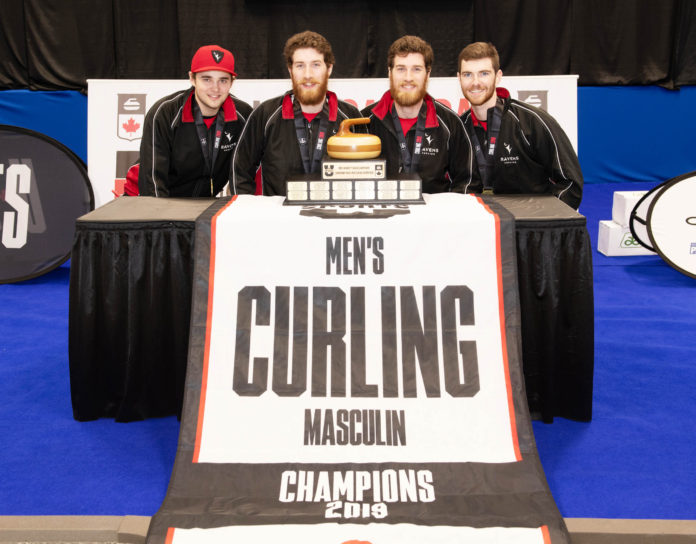
Varsity athlete is the ultimate title. It’s worn like a badge of honour by any proud student athlete. Next to it, competitive club member just doesn’t have the same ring.
Of the 29 sports teams that make up the athletic body at Carleton University, only 13 are officially classified as varsity. The other 16 are known as “competitive clubs.”
According to Jennifer Brenning, assistant vice-president of Recreation and Athletics, the deciding factors in a sports team’s classification as a competitive club is “based on participation.”
“It’s a different evaluation criteria. We’re looking for positive student engagement and participation numbers,” she said. The objectives for varsity, in comparison, “are quite high.”
However, this is not the only factor. Alongside participation, competitive clubs are judged on ability to host events and fundraisers, and total level of funding.
According to Brenning, a full varsity review has not been done since 2009. However, the Carleton Ravens football team regained their status as a varsity sport in 2013 after it was disbanded in 1998.
The transition was self-funded with both the school and the team agreeing that the sport be largely supported off alumni donations. This was done because athletics is an ancillary service at the university, said Brenning.
Funding had to also cover not only their own expenses, but those of the women’s rugby team which moved from a competitive club to a varsity team to promote equal gender representation amongst Carleton sports.
“That was a condition on bringing football back, that they would fund a women’s program. But it’s not written anywhere, we certainly have a process but we need to consider gender equity,” said Brenning.
If clubs want to follow in the footsteps of football and women’s rugby, competitive clubs must resort back to a “pretty extensive review” from Carleton University’s Department of Recreation and Athletics, said Brenning.
“It would be a matter of our department going through another pretty extensive review of what’s varsity and what’s a competitive club… we have to determine what’s required to bring that club to varsity level.”
Finding funding
Within the Competitive Sports Clubs Criteria for Consideration and Evaluation manual, each competitive club receives a grant at the beginning of the season from Carleton ranging from $500 to $4,500, but funds run out fast.
As a result, athletes pay certain fees, sometimes up-wards of $1,000, run fundraisers (including the famed Giving Tuesday project), and apply for grants to makeup the difference. The Carleton University Students’ Association can also help provide funding.
Carleton’s men’s curling club is one team that has not made progress towards increased funding levels or potential varsity status even after winning gold at the 2019 U Sports nationals.
“Total funding amount is about the same this year as last, no change due to nationals,” said Tom Sinclair, a coach for the men’s curling club.
In fact, the club reached out to a secondary organization, the Ontario Curling Council, and applied to their Next Generation Program in search of supplementary funding. The team was awarded a total of $2,500.
There are also no clear guidelines on how much fund-ing would be required to push for varsity status, said Sinclair.
“We honestly don’t know what would be considered to be a level of funding through varsity. That’s not a conversation that we’ve ever had or even [have] been encouraged to have at Carleton.”
This leaves competitive clubs stuck in a cycle of underfunding, said Lynn Marshall, manager and assistant coach of swimming at Carleton.
“With more money for the team, as well as scholar-ships to offer to elite level swimmers to encourage them to attend Carleton, our performance would definitely improve. And, yes, that would give us the possibility to achieve varsity status.”
Participation Numbers
Despite a lack of funding creating barriers to recruitment, competitive clubs are still attracting large numbers of participants to their sports.
For sports such as men’s rugby and men’s curling, participation numbers have actually been growing, and show no indication of slowing down anytime soon.
“Competitive curlers who are aware of the opportunities within Carleton Ravens curling are still very much interested in putting their names forward,” said Sinclair.
The same goes for Carleton’s men’s rugby according to Ken Lemieux, a player and club president.
The difficult process of making the leap to varsity hasn’t stunted the turnout rate for the team.“The criteria to do it… [there’s] a lot of hoops to jump through,” said Lemieux.
“They don’t really give it super clear cut because it’s up to the discrepancy of a lot of people. We ran into a ton of bureaucratic issues this year with things as minor as the colour of our shirts.”
“The one thing that we are lucky to have is that we have 50 guys who come out that are out there for the love of the sport really, they’re not doing it for free.”
Feature image from file.





